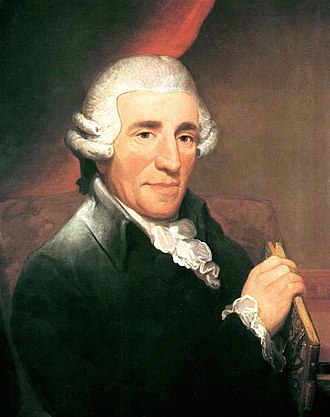
The Symphony No. 94 in G major is the second of the twelve London symphonies written by Joseph Haydn. It is popularly known as the Surprise Symphony.

Symphony No. 39 is a symphony in G minor by Franz Joseph Haydn in 1765, at the age of 33 under the beneficence of Prince Nikolaus Esterházy. It is the earliest of Haydn's minor key symphonies associated with his Sturm und Drang period works. The work was influential and inspired later G minor symphonies by Johann Christian Bach and Wolfgang Amadeus Mozart.

The Symphony No. 6 in D major is an early symphony written in 1761 by Joseph Haydn and the first written after Haydn had joined the Esterházy court. It is the first of three that are characterised by unusual virtuoso writing across the orchestral ensemble. It is popularly known as Le matin (Morning).

The Symphony No. 84 in E♭ major, Hoboken I/84, is the third of the six Paris Symphonies written by Joseph Haydn. It is sometimes known by the subtitle In nomine Domini.

The Symphony No. 72 in D major is a symphony by Joseph Haydn. The symphony was probably composed between 1763 and 1765. The date of this composition is earlier than its number suggests. This work is not well chronologically placed in the Hoboken numbering system: it was composed fifteen to twenty years before the neighboring works.

Symphony No. 67 in F major, Hoboken I/67, is a symphony by Joseph Haydn. It was composed by 1779. The Haydn scholar H. C. Robbins Landon calls this work "one of the most boldly original symphonies of this period."

The Sinfonia Concertante in B flat major, by Joseph Haydn was composed in London between February and March 1792. The work is a sinfonia concertante with four instruments in the solo group: violin, cello, oboe and bassoon. It is believed to be a response to similar works composed by Ignaz Pleyel, a former student of Haydn's who London newspapers were promoting as a 'rival' to Haydn. In addition to the solo group the Sinfonia Concertante is scored for flute, 2 oboes, 2 bassoons, 2 horns, 2 trumpets, timpani and strings.

Symphony No. 43 in E♭ major, Hoboken I/43, is a symphony by Joseph Haydn. Since the nineteenth century it has been referred to by the subtitle "Mercury". The source of the "Mercury" nickname remains unknown according to Matthew Rye. It could refer to its use as incidental music from some play or other given at Eszterháza, or it may not have appeared until the nineteenth century. It would certainly be wrong to impose any programmatic elements on to the abstract musical drama and search for a portrait of the gods’ winged messenger.

The Symphony No. 41 in C major, Hoboken I/41, is a festive symphony by Joseph Haydn. The symphony was composed by 1769. It is scored for flute, two oboes, bassoon, two horns, two trumpets, timpani and strings.

The Symphony No. 38 in C major, Hoboken I/38, is an early and festive symphony by Joseph Haydn. The symphony was composed some time between 1765 and 1769. Because of the virtuosic oboe parts in the final two movements, it has been suggested that the work's composition may have coincided with the employ of the oboist Vittorino Colombazzo in the fall of 1768. The symphony is popularly called the Echo Symphony, a nickname that, like all other named Haydn symphonies, did not originate with the composer.

Symphony No. 35 in B♭ major, Hoboken I/35, was written by Joseph Haydn. The autograph score is "carefully" dated "December 10, 1767". It has been speculated that this symphony was written to celebrate Prince Esterházy's return from a visit to the Palace of Versailles.

Joseph Haydn wrote his Symphony No. 36 in E♭ major, Hoboken 1/36, some time in the first half of the 1760s, around the same time as his Symphony No. 33, for Prince Nikolaus Esterházy. Scored for 2 oboes, bassoon, 2 horns, strings and continuo, the slow movement features solos for violin and cello. It is in four movements:
- Vivace, 3
4 - Adagio in B♭ major, 2
2 - Menuet – Trio, 3
4 - Allegro, 2
4

Joseph Haydn wrote Symphony No. 23 in G major, Hoboken I/23, in 1764.

The Symphony No. 7 in C major, Hoboken I/7, is a symphony by Joseph Haydn, sometimes called "Le midi", meaning "The Noon."

Joseph Haydn's Symphony No. 2 in C major, Hoboken I/2, is believed to have been written between 1757 and 1761.

Joseph Haydn's Symphony No. 3 in G major, Hoboken I/3, is believed to have been written between 1760 and 1762.

Joseph Haydn's Symphony No. 14 in A major, Hoboken I/14, may have been written between 1761 and 1763.

Joseph Haydn's Symphony No. 15 in D major, Hoboken I/15, may have been written between 1760 and 1763.

The Symphony No. 9 in C major, Hoboken I/9, is a symphony by Joseph Haydn. The symphony was composed in 1762, under the auspices of Nikolaus Esterházy, who allowed the symphony to be performed in Eisenstadt.

The Symphony No. 18 in G major, Hoboken I/18, is a symphony by Joseph Haydn. The composition date is conspicuously uncertain. The Breitkopf catalogue entry assures that it was composed no later than March 1766, the date of the Esterhazy orchestra moving to Esterhaza, but most scholars believe it was composed at least a few years before then. Dates between 1757 and 1764 have been also suggested but not proven.




